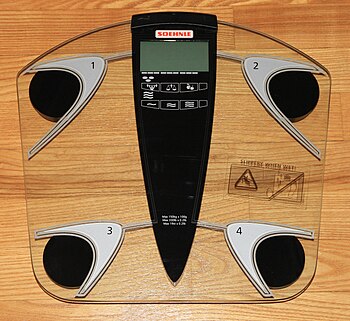So in reality, you want to reduce the amount of body fat you are carrying, but how much is healthy? If you are male, then you want your body fat to be around 10%; 15% for females.
Why the Scale is Your Worst Enemy
 |
| (Photo credit: Wikipedia) |
When you first started to eat fewer calories, you probably showed a significant drop in numbers on the scale. But because carbs bind to water, lowering your carb intake reduced the amount of water in your body, so the real loss was not body fat, but water loss – the water had fewer carbs to attach to. If you start eating more carbs again, your weight will go up proportionately due to water hanging onto the additional carbs.
As a matter-of-fact, you can lose body fat, gain muscle and your number on the scale can remain the same, even though you now look better. Why? Because a pound of muscle takes up less space than a pound of fat therefore your profile is much slimmer even though you weigh the same.
Measuring Body Fat
The only real way to measure body fat loss accurately at home is by measuring your girth in the same places each time with a pair of body fat calipers – the neck, chest, arms, waist and thighs. Your waist measurement should go down, but the rest of your measurements should go up.
Train for Success
The best overall workout strategy is a mix of cardio and strength training. Cardio burns more calories and thus speeds up fat loss, but it alone is not enough; without strength training, you’ll end up losing muscle. Through strength training, you’ll tone the muscle you have and build more. And because more muscle means you’ll burn more calories throughout the day, developing muscle mass is the key to long-term weight management.
Most likely your real goal of “losing weight” is to lose body fat and build muscle. Be sure to check back for our weekly workouts every Thursday to help you accomplish these goals!
No comments:
Post a Comment